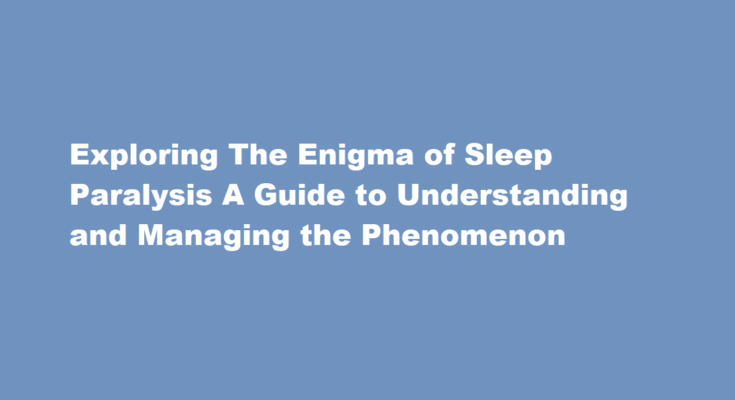Introduction
Sleep is a vital aspect of our lives, providing the necessary rejuvenation for our bodies and minds. However, not all sleep experiences are peaceful and uninterrupted. One such perplexing phenomenon is sleep paralysis, a state where the mind is awake, but the body remains temporarily immobilized. While sleep paralysis can be distressing, understanding it can help individuals navigate and even harness this enigmatic experience for personal growth and exploration.
What is Sleep Paralysis?
Sleep paralysis occurs during the transition between sleep and wakefulness, typically when falling asleep or waking up. It is characterized by a temporary inability to move or speak, often accompanied by vivid and frightening hallucinations. This phenomenon can last for a few seconds to a couple of minutes, leaving those who experience it feeling helpless and anxious.
Causes of Sleep Paralysis
- Sleep CyclesSleep paralysis is most commonly associated with rapid eye movement (REM) sleep, a phase marked by intense brain activity, vivid dreams, and muscle atonia (temporary paralysis). When the transition between REM sleep and wakefulness is disrupted, sleep paralysis can occur.
- Sleep Disorders Conditions like narcolepsy and sleep apnea can increase the likelihood of experiencing sleep paralysis. These disorders disrupt normal sleep patterns and may contribute to episodes of paralysis.
- Sleep Deprivation Irregular sleep patterns, insufficient sleep, and sleep deprivation can trigger sleep paralysis. A lack of restorative sleep can disrupt the body’s ability to regulate sleep cycles effectively.
- Stress and Anxiety High levels of stress and anxiety can exacerbate sleep disturbances, potentially leading to sleep paralysis. Anxiety can also influence the content of hallucinations during episodes.
- Sleep Position Sleeping on your back is often associated with a higher risk of sleep paralysis. This position may increase the likelihood of airway obstruction and disrupted sleep cycles.
Experiencing Sleep Paralysis What to Expect
During an episode of sleep paralysis, individuals often describe feeling awake but unable to move or speak. They may also experience the following
- Hallucinations Vivid and often terrifying hallucinations are a hallmark of sleep paralysis. These can take the form of shadowy figures, eerie sounds, or otherworldly presences.
- Pressure or Weight on Chest Some individuals report feeling as if a heavy weight is pressing down on their chest, making it difficult to breathe.
- Sensory Distortions Sensory experiences can be distorted during sleep paralysis, such as hearing voices, smelling strange odors, or feeling strange sensations on the skin.
Managing Sleep Paralysis
While sleep paralysis can be unsettling, there are strategies to manage and even make the experience more tolerable
- Relaxation Techniques Focus on remaining calm during an episode. Try to remind yourself that it’s a temporary state and will pass. Deep breathing and mindfulness exercises can help reduce anxiety.
- Improve Sleep Hygien Establish a regular sleep schedule, create a comfortable sleep environment, and avoid stimulants like caffeine and electronic devices before bedtime to promote better sleep quality.
- Sleep Position Experiment with different sleeping positions. Sleeping on your side rather than your back may reduce the likelihood of sleep paralysis.
- Stress Reduction Practice stress-reduction techniques such as meditation, yoga, or progressive muscle relaxation to mitigate anxiety, which can contribute to sleep disturbances.
- Consult a Healthcare Professional If sleep paralysis becomes frequent or significantly impacts your quality of life, consult a healthcare provider or sleep specialist. They can identify underlying causes and recommend appropriate treatments.
Harnessing Sleep Paralysis for Exploration
Some individuals have learned to view sleep paralysis as an opportunity for personal growth and exploration. Here are ways in which you can use sleep paralysis as a tool for self-discovery
1. Lucid Dreaming With practice, some people can transition from sleep paralysis into lucid dreaming. In a lucid dream, you are aware that you are dreaming and can control the dream’s narrative. This can be a fascinating and enriching experience.
2. Creative Inspiration Artists, writers, and musicians have reported drawing inspiration from their sleep paralysis experiences. Keeping a journal by your bedside to record these experiences can provide material for your creative endeavors.
3. Facing Fears Sleep paralysis often involves vivid and frightening hallucinations. Some individuals have used these experiences as opportunities to confront their fears and anxieties in a controlled environment.
Frequently Asked Questions
What is the most common way to get sleep paralysis?
Sleep experts believe sleep paralysis might be partly genetic. Other causes include stress and disrupted sleep schedules (think jet lag or pulling an all-nighter). Several studies have also found links between social anxiety or panic disorder and sleep paralysis.
What is the mystery of sleep paralysis?
Sleep paralysis occurs at the transition between wakefulness and rapid-eye-movement (REM) sleep. During this stage of sleep, you have crisp life-like dreams. To prevent you from acting out these dreams and hurting yourself, your brain temporarily paralyzes your entire body.
Conclusion
Sleep paralysis is a perplexing and sometimes distressing phenomenon that occurs during the transition between sleep and wakefulness. While it can be unsettling, understanding its causes and learning to manage it can alleviate anxiety and improve sleep quality. For those inclined toward exploration, sleep paralysis can even serve as a gateway to unique experiences and creative inspiration. Ultimately, a balanced approach to understanding and navigating sleep paralysis can help individuals make the most of this enigmatic state of consciousness.
Read Also : Mastering The Art of Bow Knots A Step-by-Step Guide



